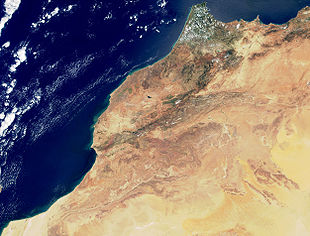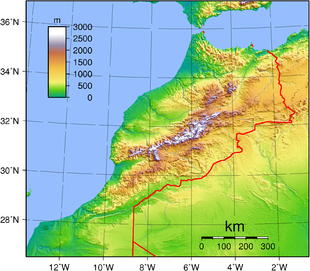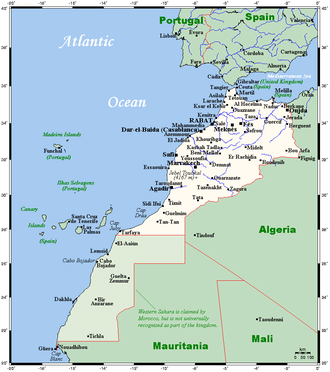
Geography of Morocco
Background to the schools Wikipedia
SOS Children have produced a selection of wikipedia articles for schools since 2005. Click here to find out about child sponsorship.
The geography of Morocco spans from the Atlantic Ocean, to mountainous areas, to the Sahara (desert). Morocco is a Northern African country, bordering the North Atlantic Ocean and the Mediterranean Sea.
A large part of Morocco is mountainous. The Atlas Mountains are located mainly in the centre and the south of the country. The Rif Mountains are located in the north of the country. Both ranges are mainly inhabited by the Berber people.
Geography statistics Coordinates: 32°00′N 5°00′W
Map references: Africa
Area:
total: 710 850 km²
land: 710 850 km²
water: 250 km²
Area - comparative: slightly larger than California
Land boundaries:
total: 2 017.9 km
border countries: Algeria 1 559 km, Mauritania 1561 km, Spain ( Ceuta) 6.3 km, Spain ( Melilla) 9.6 km
Coastline: 1 835 km
Maritime claims:
contiguous zone: 24 nmi (44.4 km; 27.6 mi)
continental shelf: 200-m depth or to the depth of exploitation
exclusive economic zone: 200 nmi (370.4 km; 230.2 mi)
territorial sea: 12 nmi (22.2 km; 13.8 mi)
Physical geography
Mediterranean, becoming more extreme in the interior
Terrain: northern coast and interior are mountainous with large areas of bordering plateaus, intermontane valleys, and rich coastal plains
Geography - note: strategic location along Strait of Gibraltar
Elevation extremes:
lowest point: Sebkha Tah -55 m
highest point: Jbel Toubkal 4165 m
Climate
Environment
Ecoregions
Terrestrial ecoregions
Mediterranean forests, woodlands, and scrub
- Mediterranean dry woodlands and steppe
- Mediterranean woodlands and forests
- Mediterranean acacia-argania dry woodlands and succulent thickets
Temperate coniferous forests
- Mediterranean conifer and mixed forests
Montane grasslands and shrublands
- Mediterranean High Atlas juniper steppe
Deserts and xeric shrublands
- North Saharan steppe and woodlands
Freshwater ecoregions
- Permanent Maghreb
- Temporary Maghreb
Marine ecoregions
- Alboran Sea
- Saharan Upwelling
Current environmental issues
Land degradation/desertification (soil erosion resulting from farming of marginal areas, overgrazing, destruction of vegetation); water supplies contaminated by raw sewage; siltation of reservoirs; oil pollution of coastal waters
International environmental agreements
Morocco is party to: Biodiversity, Climate Change, Desertification, Endangered Species, Hazardous Wastes, Marine Dumping, Nuclear Test Ban, Ozone Layer Protection, Ship Pollution ( MARPOL 73/78), Wetlands
signed, but not ratified: Environmental Modification, Law of the Sea



